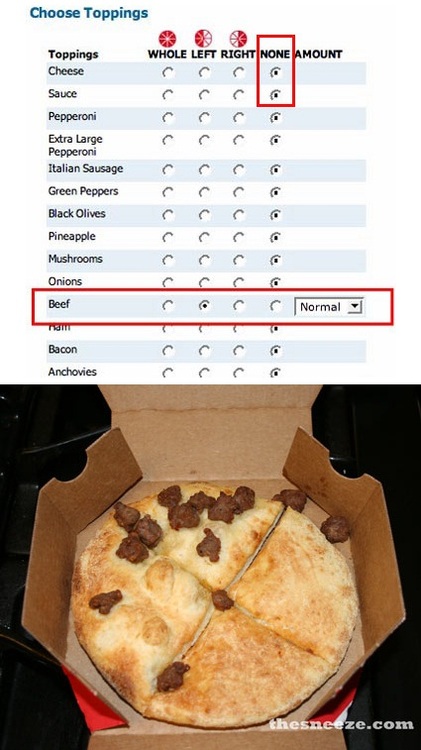You've probably already seen None Pizza with Left Beef:

What's striking to me is how funny it is each time I encounter it. Why does it make me laugh so consistently? It's sort of a jerk thing to do, really -- force some poor pizza cook to make none pizza with left beef.
I think it has something to do with the way humans interact with systems. Gradually, but steadily, since the industrial revolution, western civilization has been formalizing the systems we live in. The multiple-choice box is a perfect symbol of this movement. Are you male or female? White, hispanic, or black? Are you in the 18-24 age bracket? Do you make between $40,000 and $60,000 dollars a year? If you're calling to upgrade your cable service, press 5 now.
Multiple choice decision trees are simple ways to organize complex information for machines and math. Expert systems were an early approach to machine learning. This character-guessing bot still works the same way. Give it a try -- I'll wait here.
Multiple-choice questions lead from a single trunk, decision by decision, out to many leaves, each of which is a character; and, if the questions already present aren't enough to distinguish a character it can ask you to add another question. It shouldn't be surprising that the bot can guess even quite obscure characters. A few dozen questions (even discounting ("probably" and "don't know" answers) is theoretically enough to distinguish one billion characters.
Of course, it doesn't work that efficiently. It asks repeated questions, and guesses incorrectly once or twice if you pick obscure enough characters.
But there's still a thrill and shock when it succeeds. Why is that?
Because multiple choice questions feel like a prison. They feel limiting and presumptuous. Wizards, funnels, flows, and forms -- no matter how many different truths they can encode -- all feel claustrophobic, like they have very close horizons.
Why does None Pizza with Left Beef seem so funny and glorious? Because it is a discovery of unexpected freedom in a prison-system. The designer of the system didn't anticipate None Pizza with Left Beef. It was a discovery that emerged when a person interacted with the pizza form in a playful and exploratory way. It's a surprising moment of liberation -- admittedly of little apparent use, and bought at some expense -- but liberation, anyway, from the confines of multiple choice.
Lessons for system-builders:
- Strive for a balance. Don't offer choices you don't want users to take, but do try to prevent the claustrophobia of lengthy bureaucratic forms.
- Always expect the unexpected. Users will find ways to play games, to tell surprising truths, and invent combinations you cannot foresee. Build robustly.